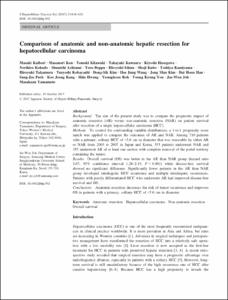Comparison of anatomic and non-anatomic hepatic resection for hepatocellular carcinoma
- Keimyung Author(s)
- Kang, Koo Jeong
- Department
- Dept. of Surgery (외과학)
- Journal Title
- Journal of Hepato-Biliary-Pancreatic Sciences
- Issued Date
- 2017
- Volume
- 24
- Issue
- 11
- Abstract
- Background:
The aim of the present study was to compare the prognostic impact of anatomic resection (AR) versus non‐anatomic resection (NAR) on patient survival after resection of a single hepatocellular carcinoma (HCC).
Methods:
To control for confounding variable distributions, a 1‐to‐1 propensity score match was applied to compare the outcomes of AR and NAR. Among 710 patients with a primary, solitary HCC of <5.0 cm in diameter that was resectable by either AR or NAR from 2003 to 2007 in Japan and Korea, 355 patients underwent NAR and 355 underwent AR of at least one section with complete removal of the portal territory containing the tumor.
Results:
Overall survival (OS) was better in the AR than NAR group (hazard ratio 1.67, 95% confidence interval 1.28–2.19, P < 0.001) while disease‐free survival showed no significant difference. Significantly fewer patients in the AR than NAR group developed intrahepatic HCC recurrence and multiple intrahepatic recurrences. Patients with poorly differentiated HCC who underwent AR had improved disease‐free survival and OS.
Conclusions:
Anatomic resection decreases the risk of tumor recurrence and improves OS in patients with a primary, solitary HCC of <5.0 cm in diameter.
- Keimyung Author(s)(Kor)
- 강구정
- Publisher
- School of Medicine (의과대학)
- Citation
- Masaki Kaibori et al. (2017). Comparison of anatomic and non-anatomic hepatic resection for hepatocellular carcinoma. Journal of Hepato-Biliary-Pancreatic Sciences, 24(11), 616–626. doi: 10.1002/jhbp.502
- Type
- Article
- ISSN
- 1868-6974
- DOI
- 10.1002/jhbp.502
- Appears in Collections:
- 1. School of Medicine (의과대학) > Dept. of Surgery (외과학)
- 파일 목록
-
-
Download
 oak-2018-0001.pdf
기타 데이터 / 518.24 kB / Adobe PDF
oak-2018-0001.pdf
기타 데이터 / 518.24 kB / Adobe PDF
-
Items in Repository are protected by copyright, with all rights reserved, unless otherwise indicated.